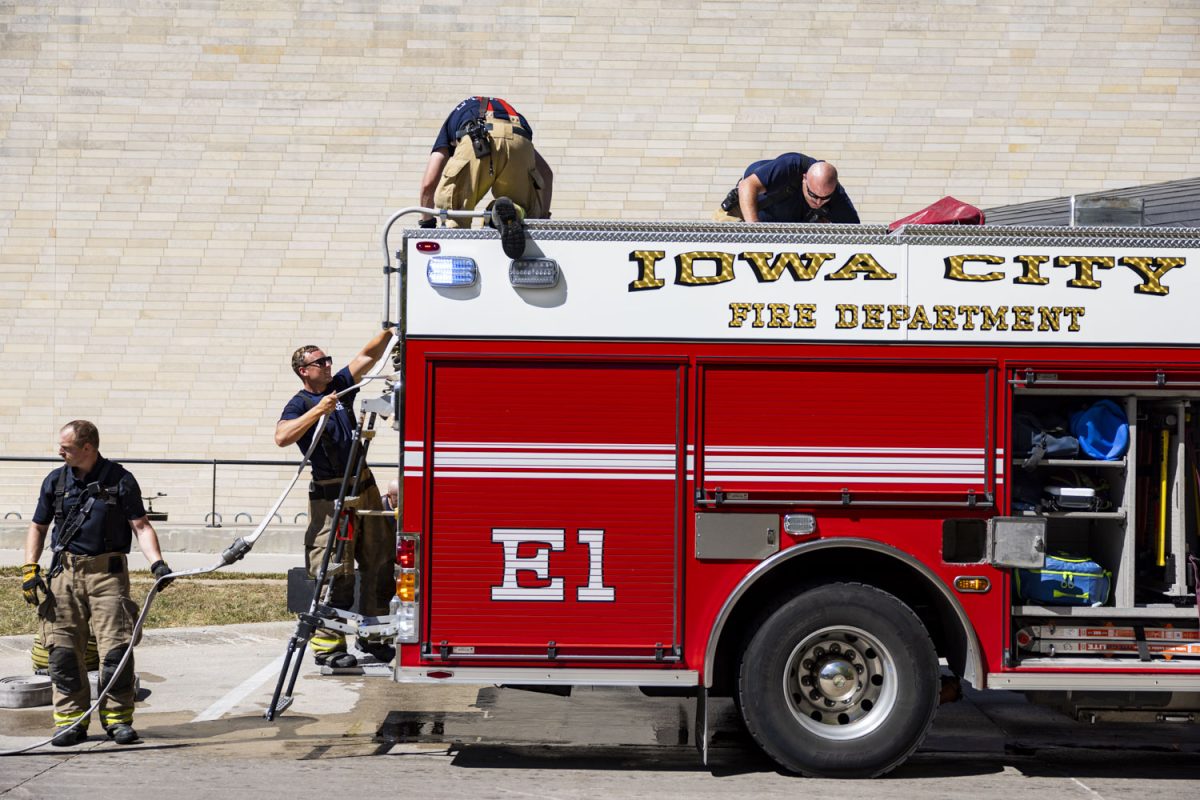The process and efficiency of Hawk Alerts, the University of Iowa’s emergency notification system, have been questioned by some students after an emergency incident last week during normal class hours.
Some students were confused about what action to take after the Hawk Alert was sent out the morning of April 4, originally warning them of a man who was reportedly making knife threats near Van Allen Hall on the east side of the UI campus.
Iowa City reports later stated the man did not make direct threats against people with the knife, and no injuries were reported. During the event, some students were uncertain about whether or not they should attend classes on campus, and some courses were moved online out of safety concerns.
The initial alerts did not indicate what the man looked like, what direction he traveled in, or if he was threatening people with the knife directly. Lee Hermiston, Iowa City public safety information officer, wrote in an email to The Daily Iowan that both UI and Iowa City police responded to the situation.
“Police searched the area, but the suspect had fled the scene,” he wrote. “At this time, there is no known threat associated with this incident. Community members are encouraged to contact local law enforcement should they see something that appears dangerous or out of place.”
When it comes to threatening situations, there is a different response depending on the instance itself, according to the UI Campus Safety Emergency Response Guide. The guide includes response procedures for fires, severe weather, medical emergencies, chemical spills, bomb threats, floods, personal crises, and active shooter or armed assailant situations.
According to the guide, the UI adopts “a layered approach to share information with campus and the community during an emergency.” In the case of an active shooter or armed assailant situation, students and faculty are advised to seek safety and call 911, as well as be ready to run, hide, or fight.
Hayley Bruce, UI Campus Safety chief of staff and public information officer, wrote in an email to the DI that each situation is different and dynamic, which is why the university sends out updates and additional alerts as circumstances shift.
“Campus Safety is very intentional when communicating emergency instructions via Hawk Alert. Our emergency instructions are tailored based on the latest information available to the police. As situations change, we update the instructions accordingly. If a threat becomes more serious, our instructions will reflect that urgency,” Bruce wrote.
In the April 4 incident, the Hawk Alert was put out as a general safety measure.
“We notified campus of this incident out of an abundance of caution, so students, faculty, and staff had the information they needed to stay safe, be aware of their surroundings, and take any appropriate precautions,” Bruce wrote.
If the circumstances of the event had shifted and become a higher risk to the UI campus, Bruce wrote that there would have been an additional Hawk Alert sent out with updated emergency instructions.
“Again, each situation is different and whether we would direct campus to secure-in-place depends on the specific circumstances of the safety threat. Our priority is life safety,” Bruce wrote.
Threatening behavior can be considered many different actions, according to the UI Campus Safety website. Some examples from the website include:
- Threatening or harassing phone calls, emails, or social media
- Bizarre or delusional statements or communications, especially if they include violent content or intentions
- The recent acquisition of weapons or increased practice in a troubled context
- Verbal, written, or communicated threats, especially if specific plans to harm or kill others are expressed
- Intense hopelessness or a sense of desperation over one’s circumstances
Less than an hour after UI students first received the alert on April 4, the UI community was told to return to normal activities while the suspect had not been apprehended. However, for students who had classes near Van Allen Hall, resuming normal activity meant choosing between attending mandatory classes or potentially walking into an unsafe situation.
Past events where the UI community has been advised to “resume normal activity” before a suspect has been taken into custody include instances of gunshots in February 2023, May 2023, July 2023, a stabbing in May 2023, and a sexual assault in September 2022, among more instances.
a UI first-year student Radhika Khanna said her morning class in Van Allen Hall was canceled on April 4 as her professor and teacher’s assistant awaited updates from the university.
“I was about to leave for class and then I got an email from my TA, and then she was like, ‘We’re going to wait till 10:30 a.m. and see if there’s another alert that says everything’s okay,’ but there wasn’t, so then she moved everything online,” Khanna said.
Khanna added she was unclear on whether attending class was the right thing to do. Ultimately, Khanna said she was glad her professor and teacher’s assistant decided to make her class virtual out of caution.
“I thought it was a good thing that they did move it online. I was actually kind of confused if they would because I’m just a freshman, so I don’t really know, but I definitely took it in a positive way that they did. I definitely think it makes the university more safe,” she said.
For UI first-year student Ellie Godsoe, the choice to attend class was a difficult one. Godsoe had class in the Biology Building, located next to Van Allen Hall, on the morning of April 4. Godsoe said she went back and forth for 30 minutes on whether or not to attend class.
“I was pretty startled when I got the Hawk Alert because this was one of the first active threat notifications I’ve received since being on campus. I was texting a couple of friends who were also concerned, and we were debating whether or not we should go to our classes,” she said.
Godsoe said at first, she was not sure of the status of classes, and she did not receive any updates from her professor before her class began.
“I didn’t receive any communication from my professors or from the university and wasn’t sure what to expect. I ultimately decided to go into class late,” Godsoe said. “One of my friends left her class in Van Allen and said that the area seemed clear from what she could see. Still, I was diligent walking over there because I wasn’t sure what to expect.”
While Godsoe ultimately did attend her class, she felt the situation could have been handled better regarding communication and student safety.
“I wish there had been more efficient communication regarding the threat, [like] where the man was or where he was going if it was safe to walk to class or not in certain areas,” she said. “I also thought it was dangerous to tell students to resume normal activity even though the man had not been apprehended yet. They likely had their guard down and could have unknowingly walked right into danger.”
Overall, Godsoe said she hopes that communication improves in the future to maximize student safety and provide a clear update on the situation as it unfolds.
“I did not think that student safety was prioritized during the situation. Despite the fact that no one was hurt, the lack of communication was just as dangerous. Students could have been walking right into a harmful situation without even knowing,” she said.
Ed Gillan, UI Faculty Senate president, wrote in an email to the DI that he has not heard of any faculty concerns following the incident last week or about the Hawk Alert system as a whole.
RELATED: Police report man making knife threats on UI campus near Van Allen Hall
“I have been at Iowa for about 27 years and have seen the positive and more informative evolution of the Hawk Alert system. I hope everyone chooses to opt-in to Hawk Alerts,” Gillan wrote. “I believe that faculty on campus rely on the Hawk Alert info to inform security and safety decisions in their buildings, offices, and classrooms.”
Gillian wrote that while he cannot speak for all faculty members, he believes that UI faculty and students value having regular updates sent to them as a situation occurs on campus.
“One recent update that I have been impressed with is pushing the Hawk Alert info to classroom desktop computers as I keep my phone silenced when I am teaching a class,” Gillan wrote. “I also find the ability to lock classroom doors electronically from inside the room to be another welcome addition.”















